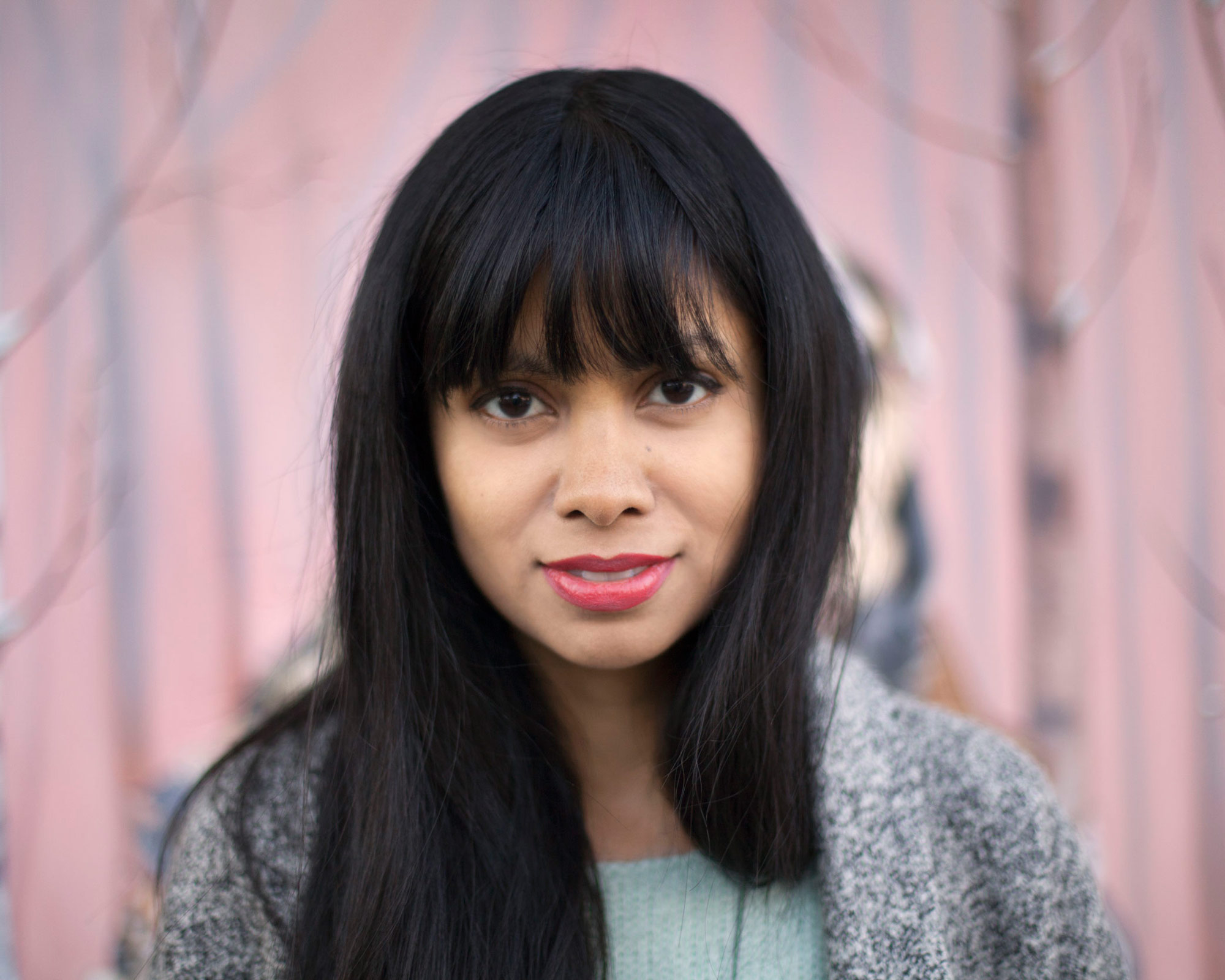
- Interview by Tina Essmaker May 6, 2014
- Photo by Paul Trillo
Shyama Golden
- artist
- designer
- illustrator
Originally from Texas, Shyama Golden is a graphic designer, artist, and painter, who is now based in Brooklyn, New York. Her work is often humorous and executed in a highly detailed, meticulous style sometimes incongruous with its subject matter. She has worked on everything from murals to oil paintings, apparel, magazine covers, illustration, apps, stickers, iconography, and logos. Her formal training is in graphic design and studio art.”
Interview
Describe your path to what you’re doing now.
As a kid, my favorite things were drawing, cats, horses, inventing strange foods, and writing and illustrating stories about cats. I tried oil painting when I was pretty young—about 11 years old. My first painting was of two neon lions roaring—a bold choice, but, hey, it was the ’90s. Actually, it was so bad that I almost never tried oils again. I did give them another try in high school and even though I still made rookie mistakes, something clicked; I realized the possibilities of the medium. I’ve done a fair amount of watercolor work and silkscreens, and I still play with Sculpey sometimes, but oil painting has a depth to it that I keep coming back to.
While I enjoyed fine art, I also had an interest in publication design and typography, which, at the time, meant fancy hand lettering to me. There was a democracy about publishing on the web, which also appealed to me, so I dabbled in that, too. Since my parents are scientists, going to school for fine art alone felt like too much of a jump; graphic design made sense as a more realistic career path. I wound up taking a lot of studio art in college, but the biggest thing I gained was a sensitivity to type and an honest and functional approach to design. It’s also amazing what a good critique can do.
After graduating college, my first two jobs came with style guides and far less creative freedom than I have these days, but I was just happy to be working and learning the software. Also, as a side note, I always did some kind of custom presentation, including a book to leave behind, when I had job interviews. That usually worked wonders. Sometimes all you have to do is be thoughtful and make a little more effort than what is expected in order to stand out. That way of thinking probably helped me even more than talent in those days.
My first job out of college was doing packaging design for kid’s watches and other products at a subsidiary of Seiko. I got very comfortable with Illustrator at that job, and near the end of my year there, I finally got a chance to do some more experimental work and see prototypes of my designs made.
I left my first job for an opportunity to work in the marketing department at Texas Monthly magazine. That job had a huge influence on me, mainly because of the environment I was in. I was 23 when I started; I still had a lot to learn, but I was looking at great design and typography every day, and I paid attention. During my last year there, they were having trouble finding someone to redesign the outdated website, so I stepped up and took that project. It was the first time I received real recognition for something that I got to own at work. I started to see the connection between creative freedom, self-motivation, and doing your best work.
After leaving Texas Monthly, I worked as a freelancer for the next three years. I did a few app and web design projects, illustration work, and a mix of whatever else came my way. It was surprisingly easy to stay employed, and not having to wake up early and go to work in a freezing cubicle was a huge bonus. I hadn’t thrived in a corporate environment, and here was this other path that I was so fortunate to discover—it gave me a chance to control my own destiny. The quality of my work also improved during this time because I was gaining a variety of experience, but, eventually, the thrill of simply being independent wasn’t enough.
I decided to stop being busy all the time and make personal work a priority. I started designing silkscreened t-shirts and prints for fun—the Illustrator skills from my first job and silkscreen classes I took in college came in handy here. The first design was a llama, because it was sort of a nickname of mine. I must have accidentally been on the forefront of the llama trend because this design really did better than my wildest dreams.
Around that time, a friend introduced me to the owner of an East Austin coffee shop, which had monthly art shows. They had an artist drop out and were looking for someone—anyone—to fill the empty space in two months. Since I wanted an excuse to do some paintings, this worked out for me. I literally finished everything at the last minute—the paint was still wet when we hung the pieces. There was definitely a moment when I wondered why on earth I had agreed to do a show based on nonexistent artwork. In the end, the self-imposed pressure worked, and I was thankful for the deadline that put a proverbial fire under my ass.
I made a lot of friends through that show and it connected me to Austin’s creative community almost overnight. Shortly after, I did another coffee shop show at Halcyon in the middle of downtown Austin during South by Southwest (SXSW). The SXSW timing—when Austin feels more packed than Manhattan—and location of the coffee shop made the show very successful.
During that time, I also started using Twitter and Dribbble to share images of my work and process online. That connected me to a lot of new people, and eventually resulted in me leaving Texas to take a design job in San Francisco. In San Francisco, I was approached by Sean Parker’s startup, Airtime. I worked as an artist there for a couple years doing illustration, murals, and design work. It was probably the only full-time job I could imagine accepting after being self-employed because I was still allowed to keep my late hours and have creative freedom.
These days I work on Sean’s personal projects when he needs design or illustration work, and I have most of my time for my own work. This is a dream come true because I have a list of a couple of years worth of things I want to make!
“Since my parents are scientists, going to school for fine art alone felt like too much of a jump; graphic design made sense as a more realistic career path.”
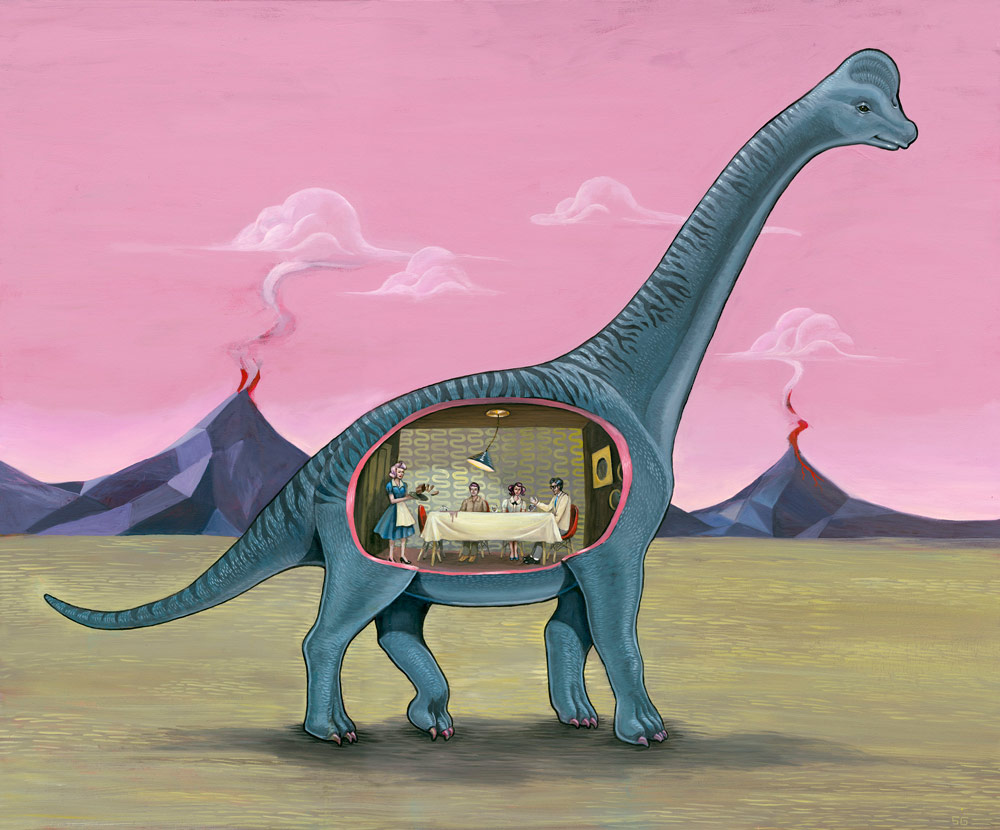
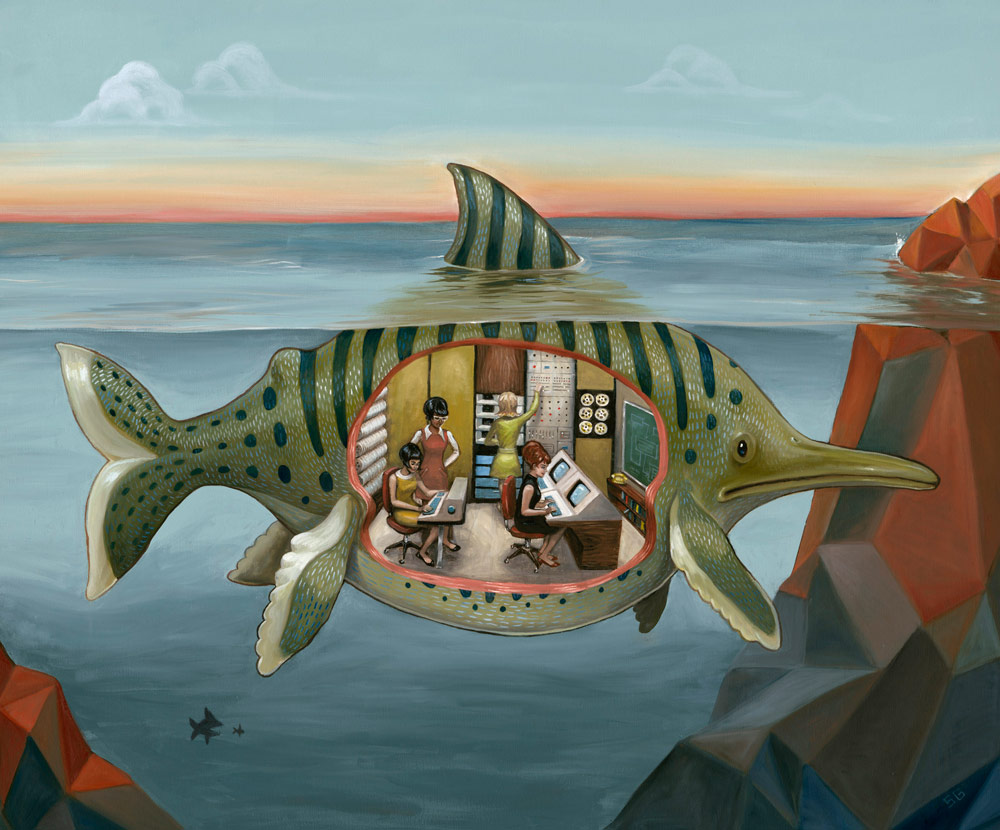
That’s awesome. How long have you been working for Airtime?
I worked there for about two years, and I’ve been working for Sean’s company, Parker Networks, since March.
So you work on different projects for Sean, not just for Airtime?
Yes, a lot of Sean’s personal projects are music-related so those are always fun. I also illustrated his wedding invitations. He had an epic wedding where no detail was spared and the invitation was a book illustrated with watercolors in the style of old Nordic fairy tales.
I had been saving up for a while in order to go back to doing studio art and leave full-time work, and then this opportunity came up, which meant I could do the same thing in a more sustainable way. It’s going to be a major turning point for me, and I feel very fortunate to work for people who are so supportive of me being an artist.
Are you selling your work and doing shows, or are you focused on creating new work right now?
I’m a lot more focused on creating than selling at the moment. I’m actually working on an illustrated book right now. My boyfriend, Paul, is a talented filmmaker and storyteller, and we’ve wanted to do a collaboration for a long time. Both of us love Sasquatch, and I love cats, so we started sketching ideas and found a way to combine the two.
That’s how I usually come up with new ideas: I have different words, images, and concepts in the back of my head that I let marinate together for a while until I figure out how to combine some of them and make something new.
The book project started when Paul drew a friend for Sasquatch that was a giant, hairy cat—the first prototype of “Catsquatch.” It gave me this very clear idea of how I would envision a catsquatch, not as one large cat, but made entirely out of many, real cats. That’s basically how the idea came about. We came up with a story about runaway cats who believe that life is better outdoors, free of human imprisonment. The cats band together into a singular creature that eventually becomes Godzilla-sized and terrorizes entire cities. The Army, Navy, and “RASA” all try to take it down before it destroys civilization.
Most of the book’s pages will be detailed oil paintings, which helps me kill two birds with one catsquatch: I’ve always wanted to illustrate and cowrite a book and have a real series of more than a dozen cohesive pieces appropriate for a gallery show. I’m going to need over a year to make this book, and this year I am able to dedicate most of my time to it.
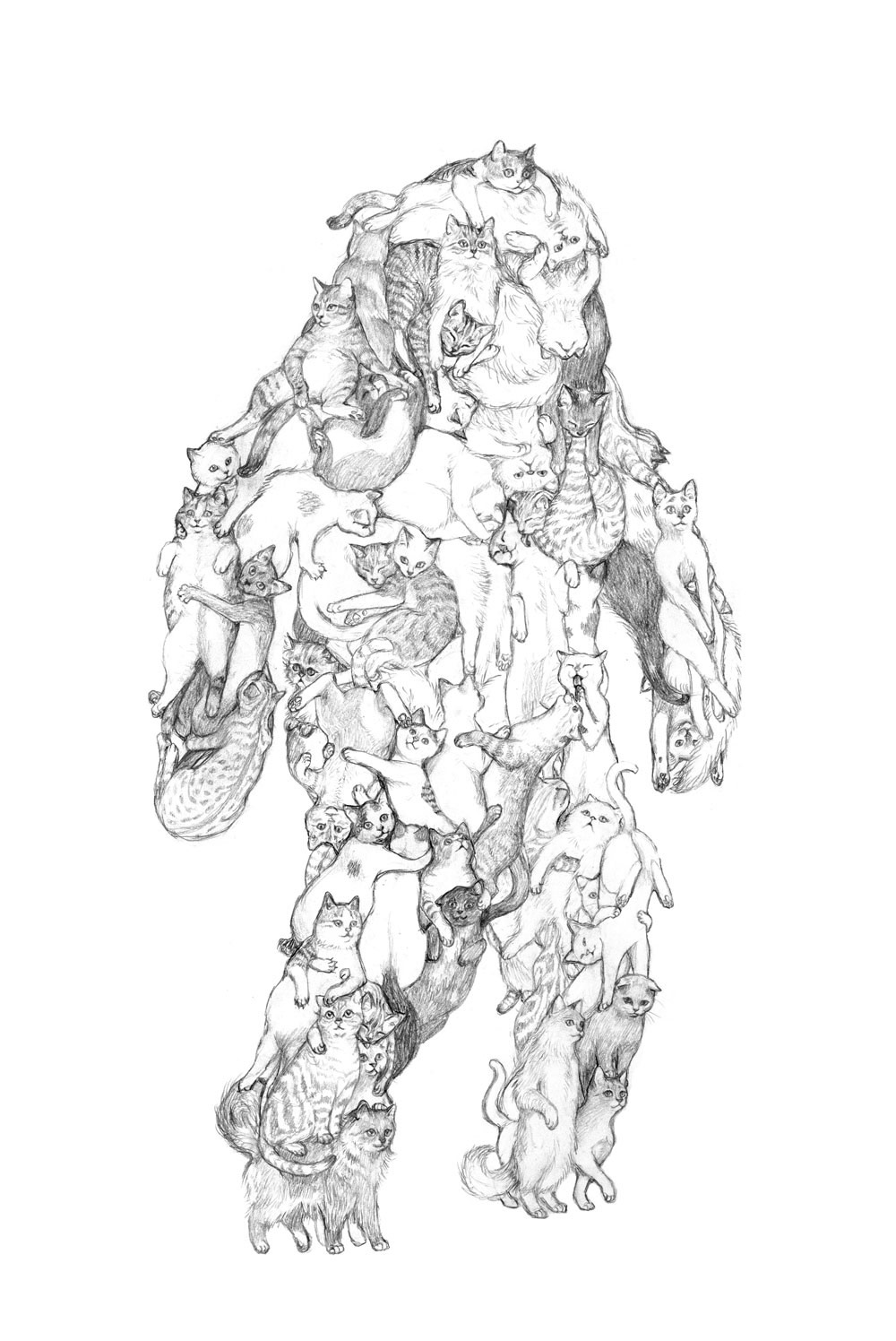
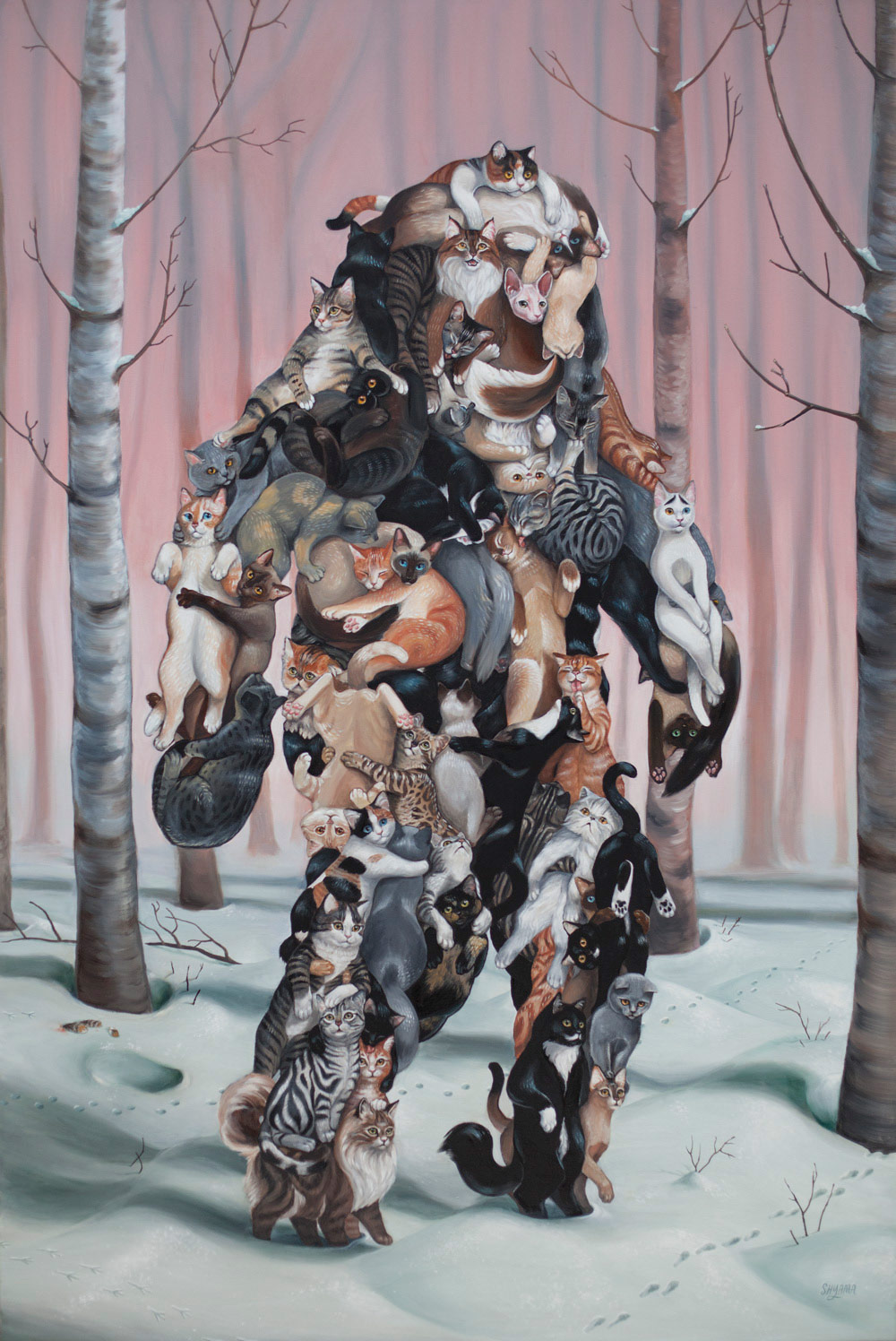
Yeah, that sounds like a lot of work. It would be difficult to do it if you were working full-time.
So true! When you’re creatively drained after your day job, you can still do some easier freelance work, but it’s much harder to get a significant amount of personal work done. For me, the amount of creative problem solving I can do in a day has a diminished return after doing the same kind of work for someone else most of the day.
It’s also difficult if you don’t have a studio space where you can leave things out. You’re already over it because you spent all of your energy getting everything ready.
Exactly! And that doesn’t even include cleaning it up.
Where did you grow up?
I was born in a small town called College Station; my mom and dad were doing their graduate studies at Texas A&M University. We moved around to different parts of Texas, but I also lived in New Zealand for a couple of years and I lived in Sri Lanka for a few years before high school.
You mentioned earlier that your parents are scientists. Did you travel because of their work?
For the most part, yeah. I moved to a new city about every three years until I lived in Austin for seven years. That was the longest I’ve been in one place, and I loved it there!
Did you move there for school?
I actually went to school at Texas Tech University in Lubbock, but I landed my first job in Austin after I graduated.
Was there an “Aha!” moment when you realized what you wanted to do or that you could make a living as a fine artist?
Yes, I think it was when I had my show at Halcyon and was able to sell most of my paintings. I was making things because I wanted them to exist and it was nice to know that they happened to be things that other people wanted. Large-scale work is hard to ignore, but it’s harder to sell, too. I was pleasantly surprised.
Have you had any mentors along the way?
One of my college professors, Dirk Fowler, was a great mentor. I have a lot of his letterpress prints hanging up all over my apartment and his design is a big inspiration. I love his work because it’s usually witty and always smart.
“…sometimes the risk is absolutely worth it! I left the city I loved on what felt like an impulsive whim, but maybe I intuitively knew that I needed to take on the next challenge.”
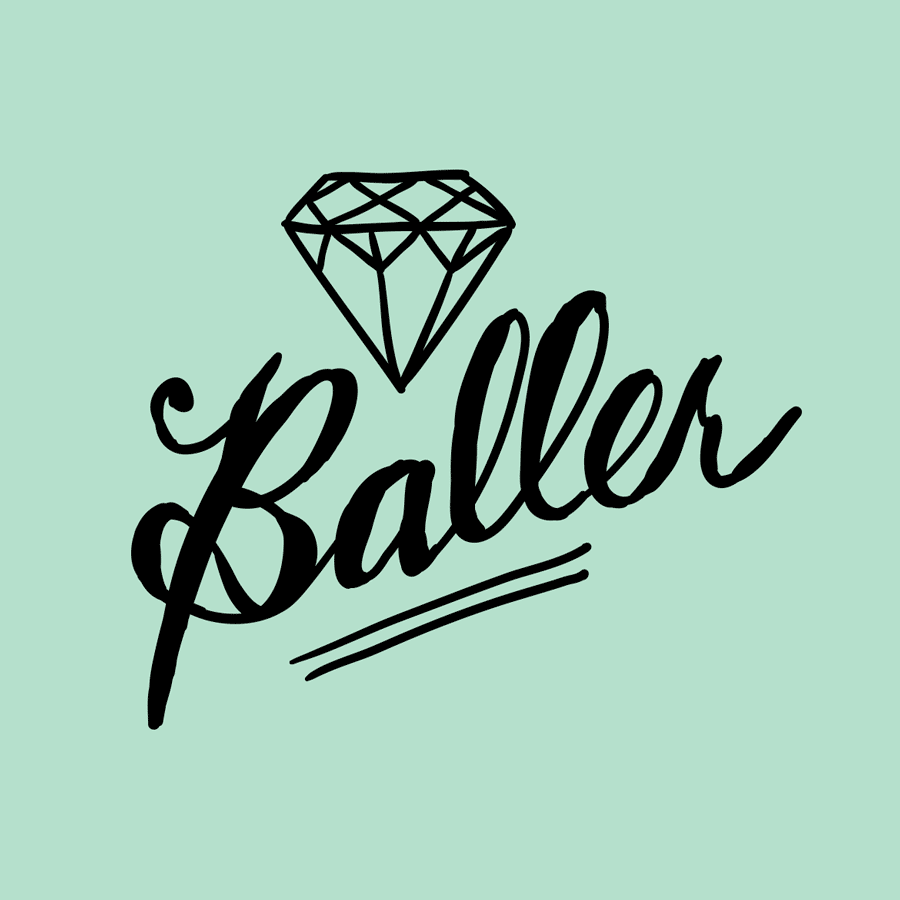
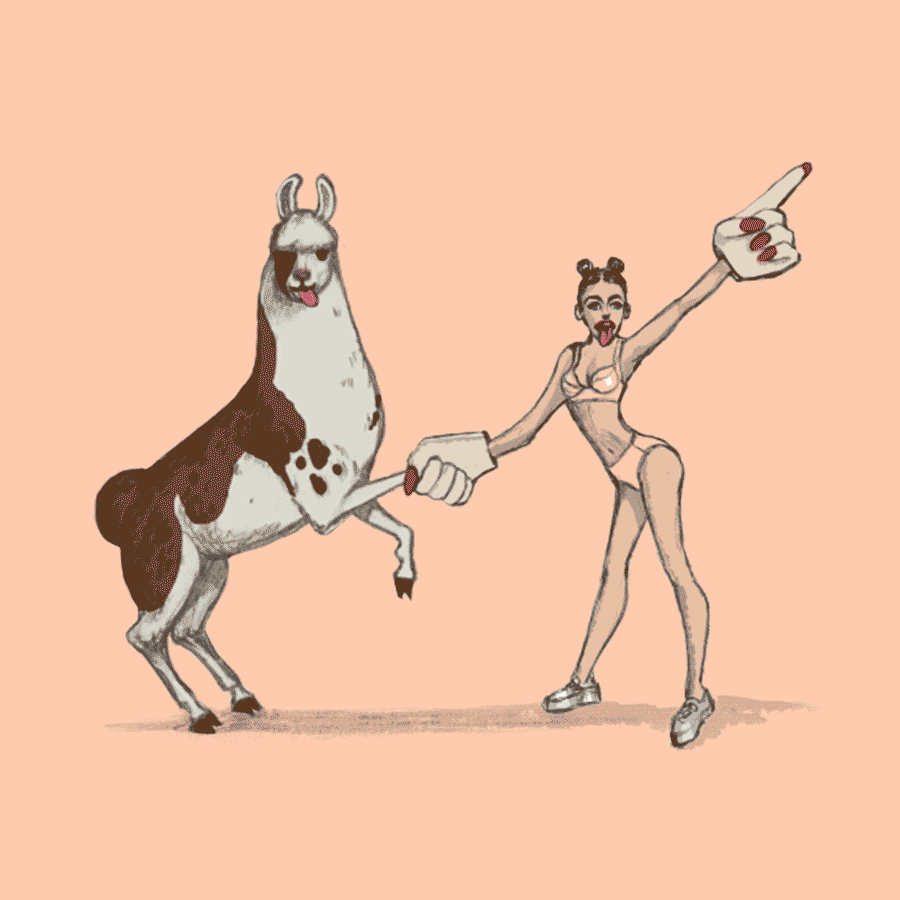
Has there been a point when you’ve decided to take a big risk to move forward?
Leaving Austin was probably the biggest risk I’ve taken. I felt like a part of something there: I had a wonderful friend group, my art was selling in a great local shop on Congress Avenue, and I had the perfect apartment. Things were just starting to take off for me.
When I moved to San Francisco for full-time work, it all came to a halt. For the most part, I couldn’t share what I worked on, and I didn’t have the energy for personal work anymore. It was the best full-time job I could imagine, but I wasn’t making my own art in San Francisco after gaining so much momentum in Austin. I was starting to lose opportunities for growth as an artist. Anyone who followed my work thought I had disappeared.
Two years later, a few significant things happened as a direct result of leaving Austin for San Francisco. I’m now in Brooklyn, and I have a great job that allows me the flexibility and time I need to make my art again. Also, I would never have met my boyfriend if I hadn’t lived in San Francisco. Finally, that led to our current book collaboration, which is the most ambitious thing I’ve ever taken on. The point of all of this shameless bragging is that sometimes the risk is absolutely worth it! I left the city I loved on what felt like an impulsive whim, but maybe I intuitively knew that I needed to take on the next challenge.
Are your friends and family supportive of what you do?
When I was a kid, my parents always encouraged me. They have carefully saved and documented so much of my old work, starting from the earliest scribbles. At one point, they encouraged me to do something a little more respectable, like architecture, but when it became clear that that wasn’t going to be me, they were completely understanding and supportive. My friends have been amazing, too. They have come to my shows, helped me practice talks, and helped me see my work with fresh eyes when I’ve been staring at it too long—that’s invaluable.
Do you feel a responsibility to contribute to something bigger than yourself?
Something my parents taught me is to make sure whatever it is you do for a living contributes in some positive way to the world, even if it’s something small. When someone tells me that seeing my work brought them some happiness, then I feel like it’s doing what it is supposed to!
It’s rewarding to put out work and receive feedback directly from your audience.
Right. That is part of why I like painting. The other reason is that it stays relevant much longer than interactive work, at least for me. While anything you create will one day be destroyed, there is something I find satisfying about creating things that might stick around a little longer.
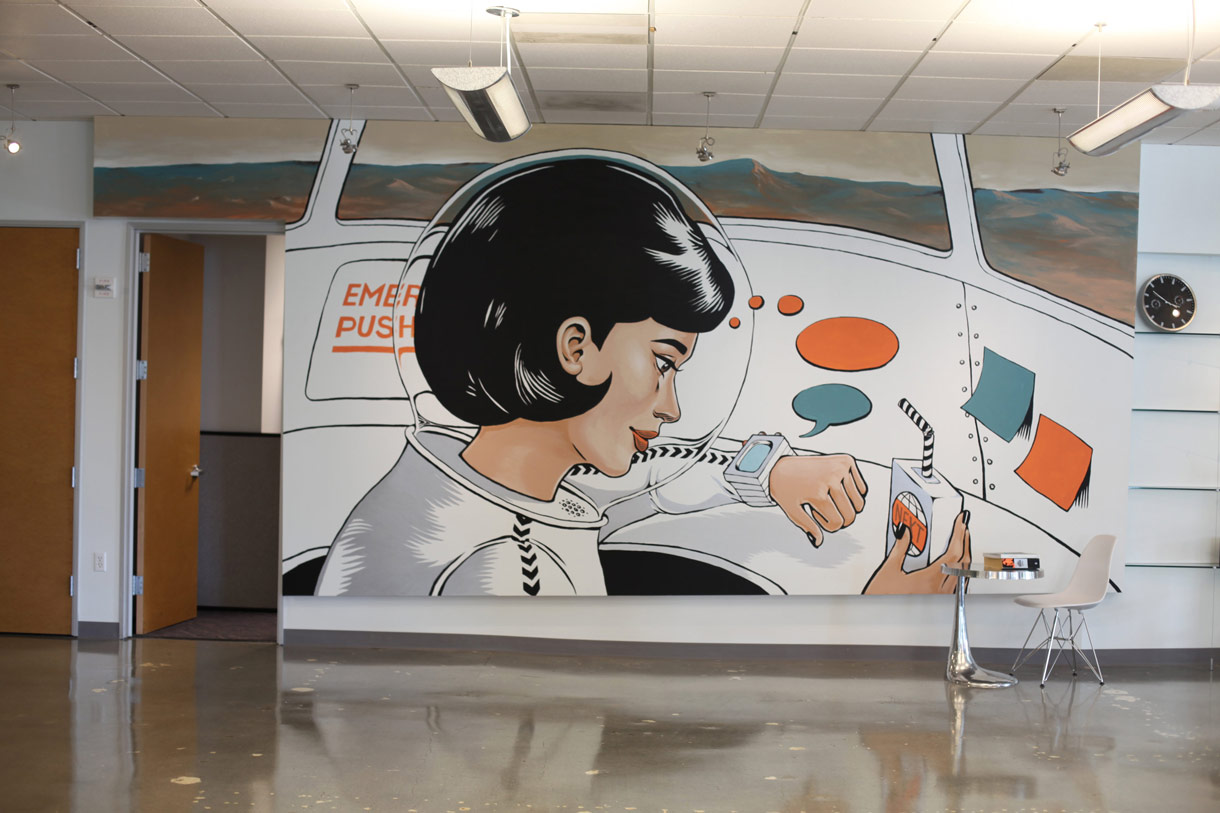
Speaking of satisfaction, are you creatively satisfied?
With what I’m doing right now, yes, I am. My biggest challenge throughout college and up until now was committing to a consistent theme and style. My work was all over the place; I didn’t know who I was as an artist. I’m finally at a place where I’m ready to tackle these things. I’m happy it’s coming together.
It sounds like you have a good direction for this year. What are you interested in beyond that?
I want to create products, to make my art into things that people can use. In the past, I’ve done prints and shirts, but I want to take it further than that. I have ideas for a series of textile patterns and wallpaper designs. I want to make my first real OpenType hand-drawn fonts and I also plan to start a new Pouty Portraits series of sad people in happy scenarios. I recently started learning animation and that’s an area where I want to learn a lot more.
Wallpapers and textiles would be really cool.
Yeah, I’m excited about it!
What advice would you give to someone who is starting out?
When you’re starting out, the most valuable thing is to seek out someone you respect and can learn from. I rarely had someone like this, but when I did, I realized how much influence their critiques had on my work.
Another thing that helped me a lot was to keep an inspiration file of things I like. The point is not to copy them, but to figure out what your tastes are by seeing what the things you like have in common. This helped me start creating work I liked.
Third, it’s probably a good idea to invest some time and effort into a decent website if you’re starting out. In the beginning, that helped me out a lot.
You’ve lived in Austin, San Francisco, and Brooklyn. How have those places influenced your creativity or work?
I can definitely say how Brooklyn influences my work. Living here has made me think more about doing products and textiles and publishing, because all those industries are here. Having those opportunities now makes me want to take advantage of them, which influences my decisions about what direction to go in.
In some ways, my work is nostalgic; it’s handmade and humorous. I think all three cities—Austin, San Francisco, and Brooklyn—have some of those sensibilities.
Is it important to you to be part of a creative community?
Definitely. It really jump-started my art career. Being connected to an online community translated into meeting more people in my own city. Being able to share your work with others immediately after it’s finished, or even while you’re working on it, is so valuable.
Out of curiosity, are you at a studio space?
I’m working out of my apartment in Williamsburg right now, but I’d love to find a studio space soon. It’s going to get overwhelming working out of here!
“When you’re starting out, the most valuable thing is to seek out someone you respect and can learn from. I rarely had someone like this, but when I did, I realized how much influence their critiques had on my work.”


What does a typical day look like?
I used to have a typical day when I worked at a company, but not anymore. That’s what I like about what I do. I do try to plan ahead, but I’m not a routine person. Each day depends on what I’m working on. For example, the past couple of weeks I basically woke up, painted all day, and went to bed. I do tend to work in bursts like that. When I’m inspired, I run with it and work as much as I can. Otherwise, I’ll do stuff like emails in the morning and save the nights for creative work. It’s not the healthiest or very socially acceptable, but I feel more creative late at night. I find that I usually reach this breakthrough point closer to midnight, maybe because I’ve been working on a piece all day. Also, everything’s quiet; there’s nothing to respond to and no distractions, which helps.
What music are you listening to right now?
I’ve been listening to Jessy Lanza’s Pull my Hair Back as well as the new Digable Planets album, Blowout Comb, on repeat. Both have different ’90s vibes, which I’m into. Like many people, I was also obsessed with Arcade Fire’s Reflector album and James Blake’s Overgrown. I listen to a lot of Feist, Bibio, Broken Bells, and Gold Panda while I work.
Any favorite movies or TV shows?
I haven’t owned a TV in many years and only watched Netflix until very recently, but now it feels like the quality of TV has gotten way better. Silicon Valley is a great series so far, especially after living in San Francisco, and because Office Space was one of my all-time favorite movies. I also love Cosmos. Seinfeld never gets old for me. I like House of Cards, and I just started watching True Detective. It’s nice to finally not be completely lost when people want to talk about what they are watching!
Your favorite book?
It’s hard to pick a favorite. The Devil in the White City by Erik Larson is one of the best books I’ve read recently. It’s based on the true story of a serial killer at the 1893 World’s Fair. It’s very dark and interesting. It ties together unexpected storylines and reads just like the best fiction.
Another all-time favorite is Factory Made: Warhol and the Sixties. It’s an enormous book that I read as research when I was doing illustrations about Andy Warhol. It brings everything that happened in New York in the 1960s into story form in an incredible way. It’s funny, bizarre, and unbelievable what the art scene in New York was like during that time.
What is your favorite food?
If you want to get very specific, spinach and a good, solid carrot cake. (laughing) I’m constantly on a mission to find the best carrot cake in whatever city I live in. I love cooking and baking experimental things and I actually cook a lot. Some of the sketchier sounding things I’ve made were black bean cake, zucchini pasta, and a savory cheesecake with salmon and dill. I’m usually up for trying the weird thing on the menu at restaurants, too.
What kind of legacy do you hope to leave?
I’ve learned that I’m terrible at predicting my own future, so I’d probably be very bad at guessing what happens. I only think about the next five years at most, but I hope I never stop making art. Hypothetically, if someone were to find my work after I’m gone, I hope it makes them smile.
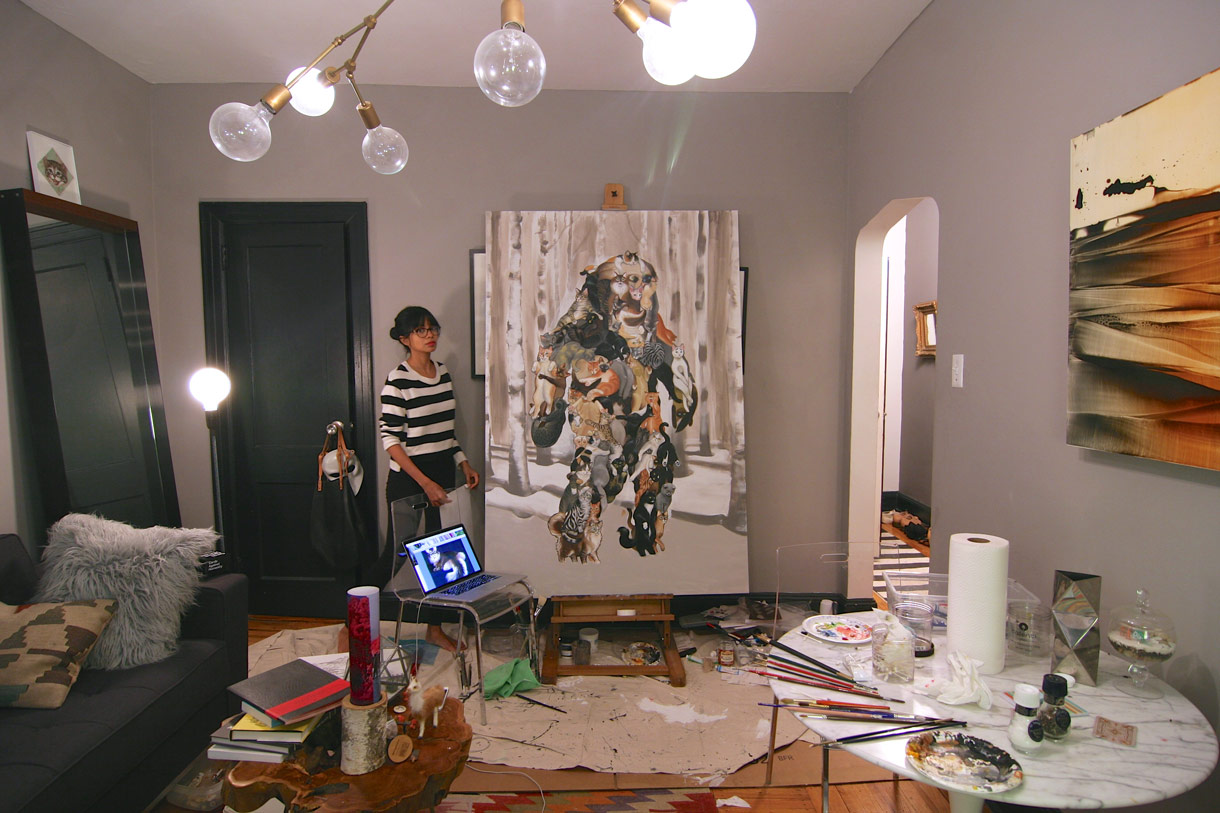
“I’ve learned that I’m terrible at predicting my own future…I only think about the next five years at most, but I hope I never stop making art. Hypothetically, if someone were to find my work after I’m gone, I hope it makes them smile.”
